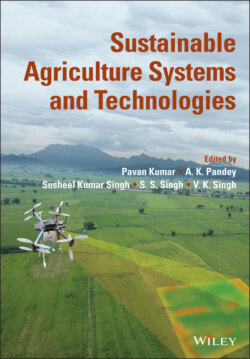Читать книгу Sustainable Agriculture Systems and Technologies - Группа авторов - Страница 29
2.1 Introduction
ОглавлениеThe agriculture is the predominant means of livelihoods of majority of the people around the world and especially in the third world countries and also land use type occupying about 40% of the terrestrial surface of the Earth (FAO 2009). It has been widely perceived that Agroecosystems are both providers and consumers of ecosystem services. Along with provisioning services (the produce, e.g. food, timber, and other raw materials), the other components of the ecosystem like plants, animals, fungi, microbials ensure indispensable regulating services such as pollination, prevention of soil erosion and water purification, and an enormous range of cultural services, as recreation and aesthetic values. Agroecosystems is the largest ecosystem, which also produces diverse ecosystem services, such as regulation of soil and water quality, carbon sequestration, support for biodiversity, and cultural services, and these are well maintained under diverse production scenarios including well‐designed crop diversification (Polasky 2008). On the planet earth, there exist half a million‐plant species but we are depending only upon rice, wheat, maize, and soybean for food security, globally. Depending on fewer crops for our food and other needs may lead to serious ecological threats in terms of increasing biotic and abiotic stresses in crop production. In spite of the vast plant biodiversity across the world, unfortunately at present 150 crops species are being used widely as now commercially important crops. More worrisome is the fact that the cereals, rice, wheat, and maize account for 60% of the world's food supply. Over seven billion people depend on the productivity of these major crops and in the near future the global population will reach to 9.0 billion and meeting the food and nutritional requirement of burgeoning population is a daunting task. The mono‐cropping constraints the provisioning services of the ecosystem. Therefore, the major crops alone may not be able to meet the world's food and nutritional requirements. The higher crop productivity of food grain crops can meet the energy demands of a mounting population; they may not provide adequate nutrition. The double‐burden of over and under nutrition (Hidden Hunger) is a major challenge. Nutrient‐poor and energy‐rich diets are linked with lack of dietary diversity. In this context, it is very pertinent to mention the significance of the cropping systems diversification to promote ecosystem services, thereby reducing dependency on external inputs while sustaining the high crop productivity. Overall, diversification of cropping ensures diversity of beneficial organisms in the ecosystem, better pollination, pest management, nutrient cycling, and water regulation without compromising crop yields (Rathore et al. 2019). Hence, aboveground biodiversity reduces pest menace and helps in water regulation, while belowground biodiversity enhances nutrient cycling, soil resilience, and water regulation. It is very common that the diversification practices resulted in enhancing the support services of the ecosystem and enhances crop productivity (Tamburini et al. 2020).
